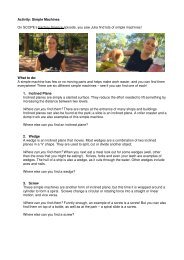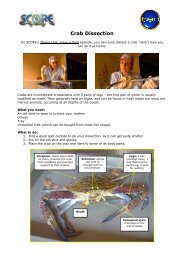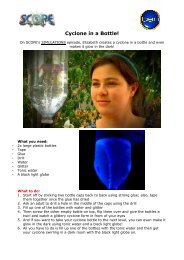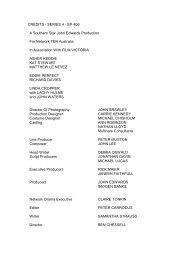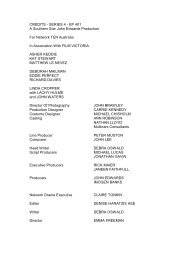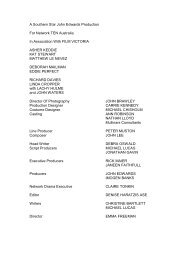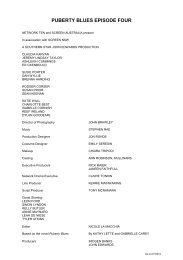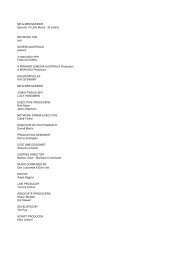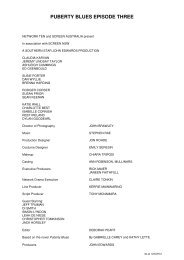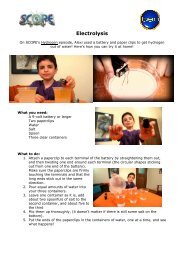You also want an ePaper? Increase the reach of your titles
YUMPU automatically turns print PDFs into web optimized ePapers that Google loves.
<strong>The</strong> <strong>Clock</strong> <strong>Reaction</strong><br />
On SCOPE's BLUE episode, Chris used a few simple chemicals to cause a sudden and<br />
predictable blue colour change. Here’s how you can try it at home!<br />
What you need:<br />
- Starch (we used laundry spray starch)<br />
- Vitamin C tablets (500 mg)<br />
- some measuring spoons, plastic cups and water...<br />
- Iodine (1%), available from a chemist<br />
- Hydrogen peroxide (6%), available from a chemist<br />
- Gloves<br />
What to do:<br />
1. Make a vitamin C solution by grinding up one tablet to a fine powder and<br />
mixing it with ¼ cup of water. Label this cup Vitamin C and don’t worry if<br />
there are floating bits.<br />
2. Label another two cups, one “A” and the other “B” .<br />
3. Into cup A, put 1 teaspoon of the vitamin C, and add some of water.<br />
You’ll need to add put about ½ teaspoon of iodine, but be sure to wear<br />
gloves and put newspaper down, iodine can stain!<br />
4. Part B starts with a little starch and water. Last ingredient in here is a teaspoon of<br />
the peroxide.<br />
5. All that remains is to mix the 2 and wait. Things actually start happening<br />
straight away even though it doesn’t look like it
What’s happening:<br />
When you initially add the iodine to vitamin C, the browny-yellow iodine colour<br />
practically vanishes, thanks to a chemical reaction that turns the iodine into<br />
iodide (colourless).<br />
<strong>The</strong>n, when you mix the two reaction parts (A and B), the iodide (colourless) is<br />
oxidise back to iodine by the peroxide. This is a slow reaction, and as soon as<br />
more iodine is formed it is reacted away by the vitamin C, back to the<br />
colourless iodide.<br />
But, after a short while, the vitamin C is all reacted, and at that moment there<br />
is now iodine available, and it reacts with the starch present to produce the<br />
sudden inky blue colour. Essentially the timing of the clock is due to the<br />
amount of vitamin C, vary it slightly to change the timing of your “clock”.<br />
Iodine + Vit. C Iodide (colourless) {quick reaction}<br />
Iodide + Peroxide Iodine {slower reaction}<br />
Iodine + Stach Blue colour {Iodine can even be used to test for starch}<br />
Now if you can manage to measure out all your things really accurately, the<br />
reaction will take exactly the same time, every time, but that can be pretty<br />
tricky.<br />
In Chris’s experiments, his three versions took 47 sec, 1.06 sec and 1.01 secs<br />
So not too bad really.<br />
<strong>The</strong> leftovers can go down a sink, and the cups and spoons are now for<br />
experiments only.



